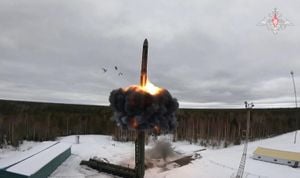Recent advances and endeavors in space exploration show the significant strides being made globally, highlighting international cooperation, technological progress, and the scientific gains being made as humanity reaches for the stars. Notably, recent developments have involved collaborative satellite programs between China and Brazil, along with the launch of key European space assets aimed at tracking environmental changes.
The planned launch of the CBERS-6 satellite is one such shining example of cooperation between China and Brazil. This satellite, which will be the seventh installment of the China-Brazil Earth Resources Satellite (CBERS) series, is set to weigh around 800 kilograms and features technology from both nations. Designed primarily for environmental monitoring and resource management, CBERS-6 is scheduled to launch around 2028 from the Taiyuan Satellite Launch Center. The satellite will be equipped with microwave imaging technology, including synthetic aperture radar, enabling precise monitoring of land resources and environmental phenomena.
China and Brazil’s partnership can be traced back to 1984 when both nations initiated agreements to collaborate on scientific and technological endeavors. Since then, the CBERS mission has produced numerous satellites, with significant impacts on remote sensing capabilities. The previously deployed CBERS satellites have amassed millions of valuable images used for various applications, including agricultural forecasting, disaster response, and climate research. Rafael Lopes Costa, involved with the CBERS-4A program, noted, "The satellite and its predecessors have enabled [Brazil] to be more independent on remote sensing data." This independence speaks volumes about the growing capacity for resource management and environmental monitoring across both nations.
Meanwhile, on another front, Europe has been preparing for the launch of Sentinel-1C, part of the EU’s Copernicus program, which focuses on Earth observation, particularly tracking environmental changes. Sentinel-1C is set to replace functionalities lost from its counterpart, Sentinel-1B, which ceased operation unexpectedly last year. Scheduled to launch aboard the Vega-C rocket after extensive testing, the satellite will provide all-weather, continuous radar imagery of Earth. Its capabilities include maritime traffic detection, environmental monitoring, and natural disaster responses, emphasizing Europe’s commitment to leveraging space technology for the benefit of society.
The European Space Agency (ESA) has emphasized the importance of the Sentinel program, stating it plays a pivotal role in ensuring environmental sustainability across the continent and beyond. Ramon Torres, coordinating the Sentinel-1 mission, remarked on the success of the launch campaign, noting the collaborative effort with various teams involved. Sentinel-1C is expected to make significant contributions to initiatives such as Arctic ice monitoring and ship detection aimed at increasing maritime security.
Further underscoring these advancements, China's Tianzhou 8 cargo spacecraft recently docked with the Tiangong space station. This mission involves resupplying the Shenzhou XIX astronaut team stationed about 400 kilometers above Earth. Tianzhou 8 delivered around six tonnes of supplies, including provisions for the astronauts and materials for over 36 scientific experiments. Among these efforts, researchers are poised to explore how microgravity affects genetic and behavioral traits. Liu Wei from the Chinese Academy of Sciences expressed optimism about the knowledge these experiments could yield, intending to deepen the scientific community's comprehension of how space conditions affect biological processes.
The complexity of the missions and the diverse range of experiments realize the immense potential of space exploration not only for scientific advancement but also for practical applications on Earth, including improving health technologies and sustainable practices. The exploration also signals humanity's rather relentless pursuit of knowledge and its aspirations to make life sustainable beyond our planet. With continued cooperation and technological development, the prospects for future research and exploration appear increasingly promising. The discoveries made today will pave the way for tomorrow’s achievements, setting the stage for exciting developments to come as nations unite for common goals among the stars.



